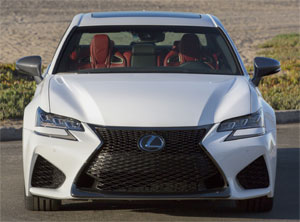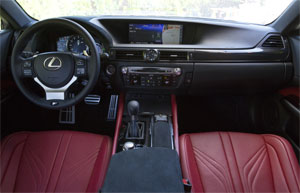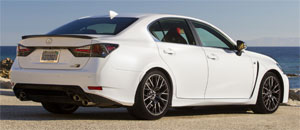2016 Lexus GS F
There have been many steps along Lexus’ path from posh to performance. The watershed one of course, was the LFA. But more recently, the IS F and RC F have helped to pick up the pace. Now there’s a new GS F for us to sample, and we’ve got a race track with many tasty turns on which to do so. Let’s see if it’s a perfect pairing for our well-seasoned palettes.
Ahh… Lexus. That purveyor of fine luxury goods that masquerade as transportation. Like any automotive brand, they’ve had their hits and misses over the years, and we’re still not sold on their current trend of putting a European performance bent to every model. But perhaps this 2016 Lexus GS F will change our opinion.
The powertrain is the same 5.0-liter V8 and 8-speed automatic transmission that has been kicking around since the 2008 IS F launched the F performance branding. But horsepower is now up to 467, and torque to 389 lb-ft.
Around Roebling Road Raceway’s high-speed twists and turns that engine sounds fantastic, even though that sound is largely synthesized. And it runs even better, with very linear feel and power delivery that seems torquier than its sibling the RC F coupe, even with identical numbers. Still, it’s nothing close to CTS-V levels of brutality.
 As for the chassis, well it’s completely competent and capable, yet not much more. Roll is subdued enough, but there’s just an overall soft feel that constantly reminds you you’re in a Lexus; as does the over 4,000-lbs of curb weight with 53% of it over the front wheels.
As for the chassis, well it’s completely competent and capable, yet not much more. Roll is subdued enough, but there’s just an overall soft feel that constantly reminds you you’re in a Lexus; as does the over 4,000-lbs of curb weight with 53% of it over the front wheels.
Still, it behaves mostly neutral with some mid-corner understeer to go along with throttle-on oversteer. The torque vectoring rear differential helps to tame that oversteer by transferring power to the rear wheel that will do the most good with it. You don’t really feel it working, but you clearly can tell the difference between Standard and Track modes.
The automatic transmission performs darn near like a sequential manual when in Sport S+ mode, with very quick gear changes when the steering wheel-mounted shifters are triggered.
Brakes were also solid, run after run; without any of the mushy feeling that usually arises in Lexus performance cars after a few hard laps.
Bottom line, we’ll call it a home run; but Lexus, drop some pounds and stiffen the suspension instead of relying on electronics to improve the handling and we might really have a grand slam.
But then, the GS F is not intended as a track car. To be one, the ultra-comfortable highway ride that Lexus owners expect would surely be history.
 Speaking of comfort, there’s a unique interior to enjoy as you effortlessly eat up those miles, and an incredible 17-speaker Mark Levinson surround sound system to help pass the time.
Speaking of comfort, there’s a unique interior to enjoy as you effortlessly eat up those miles, and an incredible 17-speaker Mark Levinson surround sound system to help pass the time.
F-exclusive gauges change themes according to Drive Mode, are easy to read at speed, and feature interactive displays like a G meter and lap timer.
Other special touches include the 3-spoke steering wheel, Heads-Up Display, aluminum-trimmed pedals, shift knob, carbon fiber trim, Metallic Dark Silver paint, Alcantara leather, and sport seats.
You definitely don’t want to be messing with the remote touch controller at speed as it’s hard to be precise with even at normal pace, but the infotainment system that it controls is very comprehensive.
Room inside is plentiful, and seats are top notch front to back. The GS F even retains all of its 14.0 cubic-ft. of trunk space.
The exterior gains some aero help by way of flared front fenders with grooved liners and air extracting vents, strategically placed under-trays, larger openings in the front fascia, sculpted rocker panels, unique side mirrors, and carbon fiber rear spoiler.
The quad tips of the stainless steel exhaust system, and available colors such as Molten Pearl, will surely shake things up in the Lexus showrooms. Lightweight 19-inch wheels with 255/35 tires up front and 275/35 rubber in the rear complete the package.
 You’ll have to walk gingerly on the gas pedal if you want to keep those rears from spinning up off the line, but a 4.5-second 0-60 is the result, when you do it just right.
You’ll have to walk gingerly on the gas pedal if you want to keep those rears from spinning up off the line, but a 4.5-second 0-60 is the result, when you do it just right.
Throughout the 13.0-seconds that it takes to complete a ¼-mile at 111 miles-per-hour, the GS F feels fiercely fast, yet still smooth and comfortable like a true luxury liner.
Likewise, shifts are about as fast as they can be without sacrificing smoothness.
Government Fuel Economy Ratings are 16-City, 24-Highway, and 19-Combined. The Energy Impact Score is just a bit worse than average at 17.3-barrels of yearly oil use with CO2 emissions of 7.8-tons.
The GS F is not exactly a performance bargain either, with base pricing of $85,390.
So the 2016 Lexus GS F may not be as big of a step up as other previous Lexus performance cars, but it is no doubt an important one. It’s well-seasoned enough to spice things up, without letting the performance flavor overwhelm the rest of the Lexus luxury dish. We predict the brand’s fans, old and new, will lap it up.
Specifications
- Engine: 5.0 liter
- Horsepower: 467
- Torque: 389 lb-ft.
- 0-60 mph: 4.5-seconds
- 1/4 mile: 13.0 seconds @ 111 mph
- EPA: 16 mpg city/ 19 mpg highway
- Energy Impact: 17.3 barrels of oil/yr
- CO2 Emissions: 7.8 tons/yr
2025 Volkswagen ID. Buzz
Volkswagen Brings Beetlemania Level Of Excitement To Minivan Segment
The duty of upholding Volkswagen’s heritage has most recently been delegated to small legacy car names like Golf and Jetta. But hold on! A much larger, totally modern take on VW’s classic microbus has just buzzed over the horizon— the all-electric ID. Buzz. It’s been at the top of our minds since we first saw the concept back in 2017. Well, it’s finally here, so let’s get our groove into drive!
This 2025 Volkswagen ID. Buzz has indeed created the most buzz around Volkswagen since the Beetle’s return to the U.S. in the late 1990s. We couldn’t drive it anywhere without drawing a crowd. No wonder, just about everyone has a VW Microbus story to tell, and seeing this reimagined version rolling down the street brings back all those memories.
VW really pulled it off as far as we’re concerned, as it looks great without appearing over the top. All the cues are here: Big VW logo front and center, lots of greenhouse including A-pillar windows and mini sliders for the second-row passengers, D-pillar air vents, and two-tone wheels. And while its appearance may be pure retro, its drivetrain is far from it, as the ID. Buzz is all-electric, and unlike the new Beetle, the Buzz does retain the original Microbus’ rear-drive architecture.
Powering those rear wheels is a 210-kW motor drawing juice from a 91-kWh battery for a range of 234 miles; 200-kW max charging will get you to 80% in about 26 minutes. Buyers can add another small 80-kW motor up front for 4motion all-wheel-drive and an increase of total output from 282 to 335 horsepower with a combined 512 lb-ft of torque. It uses the same battery, but range estimates drop just slightly to 231 miles. But while those numbers are modest, we also found them to be quite conservative, as we observed as many as 287 miles available in our all-wheel-drive tester’s gauge display and were on pace for 273 miles in our driving loop.
One throwback theme that may be a turnoff to some is that it’s quite a step up into the Buzz’s front seats, but there’s certainly a commanding view of the road once you climb in. Second row seating can be either a three-place bench or a pair of captain’s chairs, so there’s generous room for seven or six passengers. The captain’s chairs in our Pro S Plus offer good support and very easy access to the third row.
Lots of flexibility too with the option to simply fold the seats or remove them altogether.
With the sliding side doors and a wide opening rear hatch, there’s plenty of access for loading big sport utility amounts of cargo. Lots of flexibility too with the option to simply fold the seats or remove them altogether, and the ability to create a full-length flat floor with a rear cargo shelf that covers some handy removable storage bins. There’s 18.6 cubic-feet of space behind the third row, 75.5 behind the second, and a max of 145.5. That’s more than a Chevrolet Tahoe. For smaller items, there are lots of cubbies throughout the cabin, along with a standard Buzz Box that can be moved to multiple locations.
With a design that prioritizes retro form and modern function over aero efficiency, the 4motion equipped ID. Buzz earns a Fair efficiency rating, using 42-kWh of electricity per 100 miles, and we weren’t sure what to expect at our Mason Dixon test track.
What we found was great torque off the line and drama free launches to 60 in just 5.3 seconds. It was very stable at speed and power delivery stayed steady most of the way down the track until we reached about 90 mph, when it began to taper off just before we finished the quarter-mile in 14.0 seconds flat at 97 mph.
With 1,200-lbs. of battery weight nestled in its 127.5-inch wheelbase, the Buzz felt planted to the pavement through our handling course. There was quite a bit of body roll to deal with, but surprisingly little understeer. In panic braking runs, pedal response was inconsistent, feeling soft at times, pushing back hard at others; but through it all, results were quite good, stopping from 60 in an average of just 108 feet.
Three interior themes are available, this Dune is the brightest, featuring coastal inspired wood optic dash décor, “gray and clay” leatherette surfaces, and a high-mounted central 12.9-inch touchscreen. Pricing starts with a rear-wheel-drive Pro S at $61,545; this Pro S Plus begins at $65,045, add another $4,500 for 4motion, which brings a few extra features along with all-wheel drive.
Retro design with old-school VW charm, modern EV drivetrain, big SUV capacity merged with minivan flexibility; it all comes together in this 2025 Volkswagen ID. Buzz. It’s easily one of the coolest rides of the year and one that will likely keep Volkswagen dealers buzzing for years to come, and that’s something no other people and things mover can say.
Specifications
As Tested
- Motor Setup: Dual-Motor AWD
- Battery Size: 91-kWh
- Horsepower: 335
- Torque: 512 lb-ft
- EPA Range: 231 miles
- 0-60 mph: 5.3 seconds
- 1/4 Mile: 14.0 seconds at 97 mph
- Braking, 60-0: 108 feet
- MW Test Loop: ~ 273 miles













































